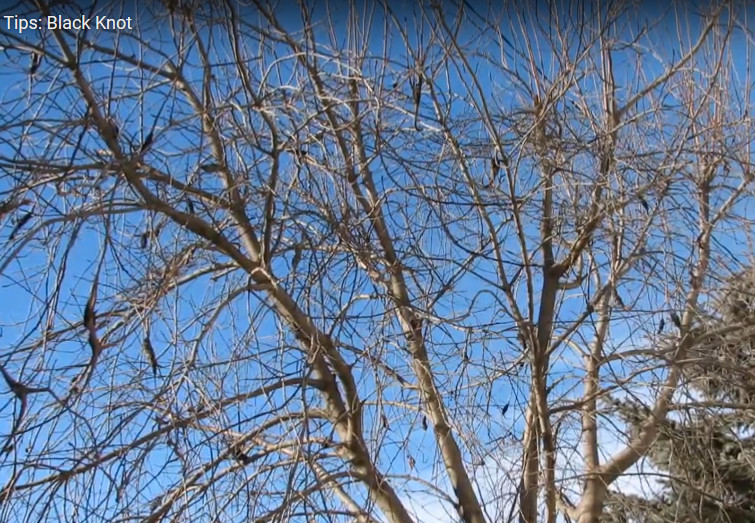
What is Black Knot?
Black Knot, is caused by the fungus Apiosporina morbosa. Infections can spread rapidly and severe infection can result in tree mortality. It is a very common disease of many pf the urban and wild fruit trees (plants in the genus Prunus). This includes plums, cherry mayday tree and others. You can find a list of susceptible tree species found in Alberta (but many of these cultivars are common in SK too):
Here is a good You-Tube video describing pruning and sanitation techniques.
How does Black knot fungus spread?
The black knot fungus overwinters in the galls on branches and trunks. Spores are released during wet periods in the spring. The wind carries these spores to trees where they infect young green shoots or wounded branches.
- The fungus grows within the branch for several months with no outward symptoms of disease. As the fungus grows, it releases chemicals that make the tree grow extra plant cells that are unusually large. This unusual growth results in the swollen, woody galls.
- Galls are made up of both plant and fungal tissue.
- One year after infection, galls can be seen as a swollen area of the branch with a velvety olive green covering of fungal growth.
- Two years after infection, the gall has turned black and hard. These galls release spores in spring when wet.
- Sometimes, the branch and the gall die after spores are released in early spring. If the branch lives, the knot keeps getting bigger and produces new spores every spring.
- The gall can completely encircle and girdle a branch. When this happens, the leaves beyond the gall wilt and die.
Steps to control Black Knot?
Essentially like all diseases proper and timely pruning and sanitation is critical
- Removal of sources of inoculum (prevents population build up)
- Prune out all knot-bearing branches during late fall, winter or very early spring when plants are dormant and knots are easy to see (note: time is of the essence to do this in 2021)
- Remove infected branches to at least 15-20 cm (6-8 inches) below knot. NOTE: It is preferable to prune an infected branch further back to an appropriate location, such as a healthy collar, rather than leave a stub
- Cutting blades MUST BE CLEANED and disinfected after pruning, especially if cuts have been made through obviously infected material. (can use Isopropyl alcohol, mild bleach solution or Mehtyl Hydrate)
- For knots on scaffold branches or trunks that can’t be removed, cut away diseased tissue down to good wood and at least 1 cm (1/2 inch) beyond the edge of the knot
- DISEASED WOOD MUST BE DESTROYED IMMEDIATELY (burned, buried or removed from site). Diseased knots can produce and release spores for up to 4 months after removal. Proper composting can help to accelerate the breakdown of infected materials.
- For proper pruning use a Certified Arborist who knows how to prune the tree properly.
Here is a link to some tips about vigilant monitoring, early detection and proper and timely control.